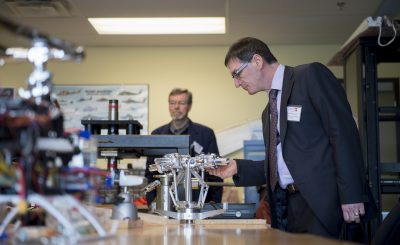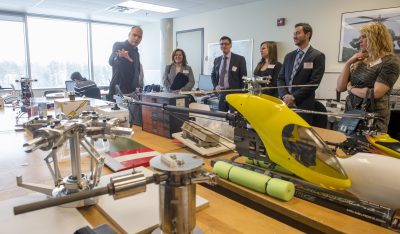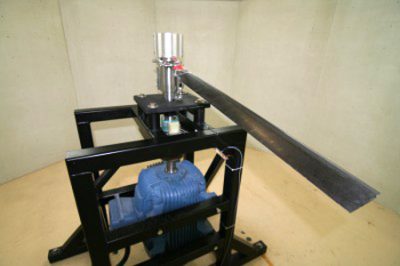 The only undergraduate program in Canada to offer a course in rotorcraft, the research conducted in the Rotorcraft Lab and tested in the Whirl Tower Facility is just as unique. Carleton rotorcraft research examines the behaviour of helicopter and wind turbine blades under numerous conditions.
The only undergraduate program in Canada to offer a course in rotorcraft, the research conducted in the Rotorcraft Lab and tested in the Whirl Tower Facility is just as unique. Carleton rotorcraft research examines the behaviour of helicopter and wind turbine blades under numerous conditions.
Carleton rotorcraft research centers primarily around two projects: SHARCS (Smart Hybrid Active Rotor Control System) and the patented “Smart Spring.”
The objective of the SHARCS initiative is to develop a blade that reduces noise from vibration in helicopters. Most of the noise comes from the rotor hub, the SHARCS blade was created to actively control elements of the blade and hub, decreasing noise from vibration.
The “Smart Spring” is a unique device that reduces the vibration in helicopters using the concept of “parametric excitation” of the blades. The Smart Spring is placed in the hub of the rotor and is able to reduce the levels of vibration of the craft. The SHARCS blade and Smart Spring result in safer and stronger structures and increased passenger comfort due to reduced noise and vibration.
 Carleton University professor, Fred Nitzsche, is leading another area of research in collaboration with international partners in Denmark, Greece, Italy, Germany and France – the use of Smart Vertical Axis Wind Turbines. Both helicopter rotor blades and the blades on wind turbines follow similar rules of aerodynamics and aeroelasticity, making research in one area applicable to the other.
Carleton University professor, Fred Nitzsche, is leading another area of research in collaboration with international partners in Denmark, Greece, Italy, Germany and France – the use of Smart Vertical Axis Wind Turbines. Both helicopter rotor blades and the blades on wind turbines follow similar rules of aerodynamics and aeroelasticity, making research in one area applicable to the other.
As the presence of wind-turbines moves from land to sea, numbers are increasing just off-shore and the need to move them further out to sea is rising. While this has yet to become an issue in Canada, it is already happening in Europe. Deep sea wind-turbines face more extreme conditions, and anchored to the sea floor, can be challenging to repair. The design and development of Smart Vertical Access Wind Turbines using SHARCS and the Smart Spring is another excellent example of Carleton research being applied real world challenges; in this case, the future of wind energy.
Whirl Tower
 Carleton University has the first and only Whirl Tower facility in Canada. A Whirl Tower enables the centrifugal testing of a rotary-wing apparatus, i.e. helicopter and wind turbine rotors or propellers, before entering a wind tunnel or flight test campaign. It is an essential facility for experimental helicopter and rotor research.
Carleton University has the first and only Whirl Tower facility in Canada. A Whirl Tower enables the centrifugal testing of a rotary-wing apparatus, i.e. helicopter and wind turbine rotors or propellers, before entering a wind tunnel or flight test campaign. It is an essential facility for experimental helicopter and rotor research.
Low RPM Whirl Tower Facility
In 2007, a specific low RPM whirl tower was erected to study helicopter-ship interactions. A six-degree-of-freedom motion platform was equipped with a low RPM whirl tower for testing the aerodynamic and aeroelastic behavior of helicopter rotor blades during take-off and landing on ships in rough seas.
The combined effect of the rotor aerodynamics, ship motion, and ship deck aerodynamics can lead to excessive deflection of the rotor blades, risking helicopter damage or danger to crew on the deck.
High RPM Whirl Tower Facility
In 2012, a high RPM facility was commissioned, designed and build jointly by the Rotorcraft Research Group of Carleton University, Smart Rotor Systems (SRS) of Ottawa, ON, and the National Research Council Canada (NRC). This has been designed to handle realistic rotor frequencies (corresponding to tip Mach number of 0.6), and dynamically scaled multi-blade rotors or propellers up to 4 meters in diameter. The frame of the Whirl Tower was designed to avoid resonance problems up to 1,800 RPM. Carleton University is the first institution in Canada to design and develop the dynamically scaled helicopter blades utilized in this facility.